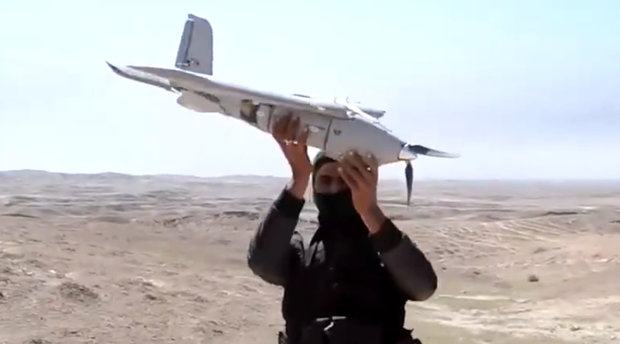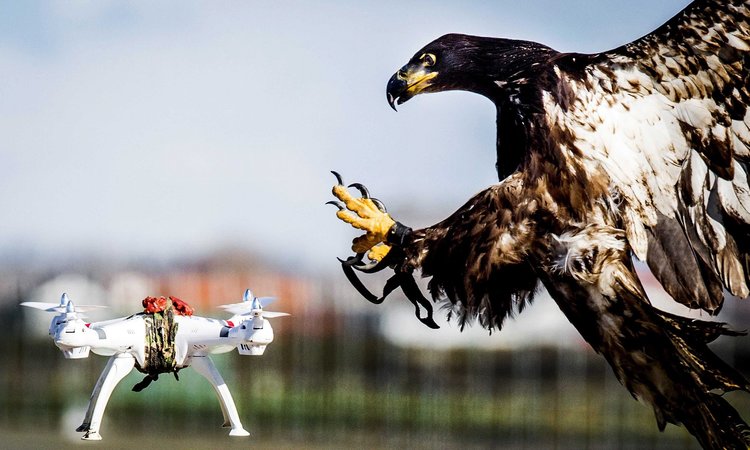 This essay is part of the #WarBots series, which asked a group of academics and national security professionals to provide their thoughts on the confluence of automation and unmanned technologies and their impact in the conduct of war. We hope this launches a debate that may one day shape policy. On 8 December 1909, British Army Major Baden Fletcher Smyth Baden-Powell was invited to give a talk at the Royal United Services Institute (RUSI). Baden-Powell had been among the first soldiers to see the use of military aviation. He experimented with flying kites and built an aircraft with his sister Agnes, and he had just stepped down as President of the Royal Aeronautical Society, the oldest aeronautical society in the world. On that Wednesday afternoon in December 1909, he spoke about “How Airships are Likely to Affect War.”
This essay is part of the #WarBots series, which asked a group of academics and national security professionals to provide their thoughts on the confluence of automation and unmanned technologies and their impact in the conduct of war. We hope this launches a debate that may one day shape policy. On 8 December 1909, British Army Major Baden Fletcher Smyth Baden-Powell was invited to give a talk at the Royal United Services Institute (RUSI). Baden-Powell had been among the first soldiers to see the use of military aviation. He experimented with flying kites and built an aircraft with his sister Agnes, and he had just stepped down as President of the Royal Aeronautical Society, the oldest aeronautical society in the world. On that Wednesday afternoon in December 1909, he spoke about “How Airships are Likely to Affect War.”
Lieutenant (later Major) Baden Fletcher Smyth Baden-Powell, Nile Expedition, 1885. (UK National Army Museum)
Making predictions about the future is an impossible task, in particular when the focus is on technologies at their beginning. History is riddled with false prophecies, be they either exaggerations or understatements: from predictions that a technology will end war once and for all—like the telegraph or nuclear weapons—to such understatements as Watson’s famous prediction that there was a global market for only five computers. It is tough to judge whether changes are ground-breaking, or only appear so from the close proximity of a contemporary. At the same time, people throughout history have ignored fundamental changes happening before their eyes, as changes took time to unfold or initially only concerned a limited area.
Academic fields also differ in their way of looking at change. Military historians are more likely to downplay developments, as their historical knowledge pushes them to draw parallels leading to conclusions that the phenomenon is not new and has been seen in some form before. Strategic Studies and International Relations scholars, on the other hand, like to emphasise novelty and make comparisons to previous moments of change. Baden-Powell was trying to walk the line between over-emphasising continuity and exaggerating change when speaking about the possible future of military manned aviation, and in this attempt he shares a bond with scholars trying to figure out just what impact the introduction of modern military unmanned aviation has had and will continue to have on future battlefields. Five fascinating parallels can be drawn between Baden-Powell’s observations in 1909 and the current situation with regard to drones.
UNCERTAINTY: WHAT TECHNOLOGY CAN ULTIMATELY DO AND WHAT SYSTEM IS BEST
In his talk, Baden-Powell dedicated much time to the discussion of different types of airships (i.e., rigid, semi-rigid, or non-rigid), and describing the respective advantages of dirigible balloons over aeroplanes, unsure which system was the most promising. He told the audience:
“What kind of machine will eventually prove the most useful and the most practical to us in war, nobody can at present venture to speak with any certainty….Day by day improvements are being made. We read of the aeroplane getting higher and higher in the heavens and of the dirigible balloon journeying longer and longer distances.”
He seemed more convinced by the capabilities of the balloon, an assessment shared by his contemporaries. H.G. Wells, in his science fiction novel War in the Air, published a year earlier, predicted a World War that heavily relied on airships: “It was like clouds fighting, like puddings trying to assassinate each other.” In this scenario, the much less powerful aircraft played only a supporting role. Today, hindsight allows us to know that airships found an inglorious end with the Hindenburg disaster in 1937. Fixed-wing aircraft and helicopters—a technology neither Baden-Powell nor Wells predicted—became the standard for airborne transport and warfare.

The Hindenburg on fire at the mooring mast of Lakehurst, New Jersey, 6 May 1937. (National Archives/Wikimedia)
With regard to drones, although most people think of fixed-wing designs similar to the Predator and Reaper, the competition about which drone system is best for which operation has not yet been won. No single design has emerged as paradigmatic of the drone. In particular, vertical take-off systems are gaining momentum for many applications, and rotor systems with four rotors (quadcopter) or six rotors (hexacopter) are increasingly sought after.
Rotor systems are attractive for militaries for two reasons. First, they do not require a runway to takeoff and land, which makes them much more versatile and flexible, and allows operations in areas where the availability of airbases limits fixed-wing systems. Second, the majority of commercial drone research and investment currently goes to vertical take-off systems, exceeding what the military has developed. While drones used to be an exclusively military technology, the civilian realm is gaining momentum fast—and underfunded and developmentally stagnant militaries hope to benefit from these investments. As the world’s richest companies are investing in the technology (Facebook, Google), this also means the next technological breakthroughs are likely to come from the civilian rather than the military realm. Many western militaries have already acquired civilian (and often foreign-built) vertical take-off systems.

The Black Hornet Nano Unmanned Air Vehicle (Richard Watt/UK Ministry of Defense/Wikimedia)
Manned systems eventually converged in a very limited number of standard classes of systems—rotary-wing, fixed-wing, and tilt-rotor—but there is reason to believe there will be a larger range of unmanned systems—particularly with regard to the size of the vehicle. Currently in use with armed forces are systems ranging from the Black Hornet—a 16-gram drone which takes off from a soldier’s palm—to the Global Hawk whose 40m wingspan rivals that of commercial airliners. Research is even looking into nature-inspired designs that resemble insects, leaving open the possibility for completely novel designs and an even wider range of possible systems.
Thus, as in 1909, we are not sure where technological development will lead, and whether one system will come out victorious, as was the case for manned aviation, or whether a wider range of fundamentally systems will coexist. The early belief in airships should teach us caution as to settling on one particular family of systems as best or ideal too early.
A FOCUS ON RECONNAISSANCE AND SURVEILLANCE
Baden-Powell in 1909 noted “the only use of aerial machines that has actually been tested and proved of use is for reconnaissance. Whether they may prove useful for other purposes is a matter of conjecture.” There is an interesting parallel to drones in this initial focus on reconnaissance and surveillance. The public fascination with targeted killings notwithstanding, the predominant use of drones remains in surveillance and reconnaissance. About 90 countries worldwide have military drones, but only about a dozen use armed drones. More importantly, Baden-Powell noted:
...this reconnaissance, as soldiers well know, is usually of far greater importance than such a matter as discharging a few explosives. It is more important for a general to receive detailed information about all that is going on in the enemy’s lines than for him to be able to destroy a few hundred men or devastate a store.
Of course, kinetic aerial attacks soon became a crucial element of military operations. Armed drones are proliferating similarly. Yet, on today’s battlefield, the reconnaissance that drones provide has proven more crucial than their kinetic use, a fact that is generally overlooked.
GLOBAL PROLIFERATION
Baden-Powell noted with concern:
In France and in Germany large airships have been built and tried with some success. Immediately there goes up a cry from the British public: we must have airships too...Aerial machines may be of the greatest value in the next war. When that war may come we do not know, but we certainly cannot afford to keep ourselves in the background any longer. We must make our own machines, have our own trails, and above all, have a staff of men trained, ready to adapt themselves to aerial machines as they become introduced.
Manned aircraft did indeed proliferate quickly and were used on both sides in the First World War (although not to the extent imagined by H.G.Wells, whose vision of aerial warfare matched the Second World War much more closely). The same trend can be observed for drones. Already today, at least 90 countries have military drones. The most recent and reliable study estimates 27 states have advanced drones, defined as those that can remain in the air for at least twenty hours, operate at an altitude of at least 5000m, and have a maximum takeoff weight of at least 600kg. At least 11 countries have armed drones, and more are pursuing their acquisition.[1] Even terrorist organisations from Hezbollah to the Islamic State operate unmanned aerial systems, although these are much less sophisticated.

ISIS using drones. (Daily Star)
Baden-Powell hinted that while the actual capabilities of aircraft were still unclear, having airships was a question of prestige. People worried about their country being left behind. Interestingly, a similar trend is at play today with regard to drones. Drones are hot; they are a symbol of modernity, technological sophistication, and military superiority. A modern military: “Unmanned Aerial Vehicles have become a must-have item for modern armies.” French Air Force Brigadier General Patrick Charaix believes:
If [France] wants to remain powerful within a coalition, we need to bring an unmanned capability to the table. Indeed, those countries that count have this military means which contributes on the one hand to the success of a mission and on the other hand increases the power and influence of the country.
MILITARY DOCTRINES: STRATEGIES FOR THE NEW TECHNOLOGY ARE STILL BEING DEVELOPED...AND REALLY MATTER
When Baden-Powell held his lecture in 1909, he sensibly assumed aerial systems were there to stay. At the time, however, the tactics and strategies that would eventually make them efficient and useful military tools had not yet been invented. There was a realization that these systems were important, but how exactly they would be used was less clear. In 1909, for example, theories of strategic bombing or air supremacy did not yet exist.
Drones have flown over the battlefield for longer than manned systems had been in use at Baden-Powell’s writing, and some tactics, most notably targeted killing, have been developed. Yet, as more militaries acquire drones and the technology improves, there is a need for more strategic thinking as to how best use these systems. More autonomy and swarming capabilities will open up new avenues. Current thinking on drones has been somewhat limited by their fast acquisition and introduction on the battlefields of the War on Terror. Different military confrontations will require new thinking. Now is the time for strategic drone thinking.
COUNTERING NEW TECHNOLOGIES
Airships and aircraft had barely taken off in 1909, and Baden-Powell already showed concern about defences: “It is of the utmost importance for us to make such provisions as we can in case war broke out with a power which possessed a number of air vessels.“ The anti-aircraft industry soon flourished. Following the same timeless logic, counter-drone systems have become a major growth area. Approximately 10% of the global research and development budget on drones is being spent on counter-drone technology.[2] Innumerable ideas have been put forward, from lasers shooting down drones, and jamming rifles, to real-life eagles being trained to take out small rogue drones.

Specially Trained Anti-drone Eagle Taking Down Its Prey in Katwijk, Netherlands. (REBRN)
CONCLUSION
There were things Baden-Powell did not imagine from his 1909 vantage point. The creation of the Air Force. Kamikaze pilots. Aircraft carriers projecting power over the ocean of the world. And he certainly did not imagine that some 100 years after his talk, the debate would be about the last manned fighter.
Baden-Powell’s talk gives a glimpse into the thinking of a military professional who lived through the advent of manned military aviation. In hindsight, what happened next appears like the logical conclusion. Yet, as Baden-Powell shows, there were many uncertainties and unknowns. Just as balloons turned out to be of limited military use in comparison to heavier-than-air systems, it may be that the current systems will, in a few years or decades, be obsolete. For the moment, drone and counter-drone technologies are proliferating and increasing in their importance to the militaries of the world. That is a reality with which strategists must wrestle, as new systems emerge and new strategies and doctrines develop—and need to be developed to take best advantage of the technology. In 1909 military manned aviation was a technology with an exciting future—just as drones are today.
No comments:
Post a Comment